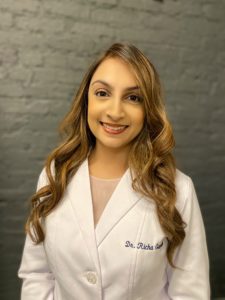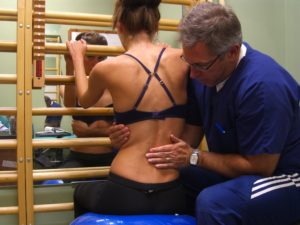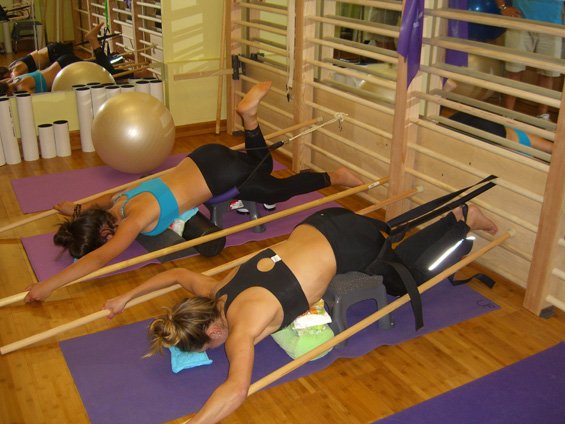December 6, 2019
Adult Scoliosis Types and Treatment Options
 Posted by Dr. Richa Gandhi
Posted by Dr. Richa Gandhi
Common Types of Adult Scoliosis and Treatment Options
Adult scoliosis is the presence of a lateral deviation in the spine which measures at a Cobb angle of 10 degrees or more in a skeletally mature patient. There are 2 common types of adult scoliosis:
Type 1: Adult Degenerative
Also referred to as Adult “De Novo” scoliosis is present in adults due to arthritis in the spine. This leads to vertebral body asymmetry which in turn causes an abnormal curvature of the spine. Most often patients present with back pain and joint stiffness. This type of curvature is most commonly located in the lumbar spine (low back).
Type 2: Adult Idiopathic Scoliosis
This curvature was present when the patient was an adolescent and has progressed into adulthood. You can think of it as a continuation of adolescent idiopathic scoliosis. Patients commonly complain of low back pain and stiffness, radiating pain down the leg and muscle fatigue. This type of curvature is most commonly located in the thoracic spine (upper back) and lumbar spine (low back) and can be shaped like an S-curve or C-curve.
Treatment Options
Non-operative:
The goals of non-operative treatment for adult scoliosis is to provide pain relief and strengthen core and spinal muscles to improve overall function and quality of life. This can be achieved through:
-Bracing
-Exercises
-Nutrition
Operative:
Surgery should be considered if non-operative treatments have been unsuccessful or for severe cases which will not respond well to conservative treatments.
August 28, 2015
The Role of Muscles In Stabilization of the Spine In Scoliosis Rehabilitation
In scoliosis specific exercise there are 2 different camps of thought when it comes to strengthening weakened muscles to help stabilize the spine. One camp believes that only the deep postural muscles of the trunk that directly attach to the spine are necessary to activate, the other camp feels that both the deep postural muscles and the more superficial muscles that attach the spine to the upper and lower lower extremities are important to activate.
A study done presented in the Spine Journal in 2004 titled Determining the Stabilizing Role of Individual Torso Muscles During Rehabilitation Exercises studied individual lumbar muscles in order to assess their potential stabilizing role by comparing and recording the Electromyography (EMG) activity produced by different skeletal muscles in both the deep and superficial layers of the spine.
The results of their study revealed that spinal stability was not dominated by any single muscle group in the spine. Instead it appeared that all the muscles in the spine dynamically changed in their level of support to the spine as the tasks the body performed altered the position of the body as controlled by the nervous system.
Based on these findings they concluded that the best strategy for enhancing motor patterns of muscles in the spine to promote stability of the spine would be best to activate the multitude of muscles involved in the action then just targeting a few of the deep postural muscles.
This supports the long held belief of the Schroth Method that it’s important to take a “Whole Body” approach to rehab rather than artificially restricting the focus to only one area of the spine.
December 1, 2014
What’s so good about the Nu-Schroth Scoliosis Method?
I recently took a call from a parent of an 11 year old diagnosed with scoliosis when she was 7 years old. During the past 4 years she has been under the care of an orthopedist who has dutifully monitored the child with x-rays during that time. At the last meeting the doctor recommended the child try some Schroth scoliosis exercises and recommended they find a local therapist trained in the 94 year old method. What changed? why did the Orthopedist suddenly recommend a nearly 100 year old method after 4 years of watchful waiting. This type of phone call has become quite common since the 2014 New York Times Article highlighting the Schroth scoliosis Method. The article is responsible for this resurgence in interest in non-surgical scoliosis treatment. In true American Fashion, we are not trying to extract out the “nutrient from the nutritious.” Let me explain, the Schroth method is an immersion technique and is provided in an in-patient setting. It includes up to 6 hours a day of therapy, massage, exercise and chiropractic. I spent two weeks at the clinic in 2008 and learned the method well. I knew when returning home I couldn’t offer an in-patient service and that I needed to modify the Schroth method to be suitable for U.S. consumption, and I didn’t want to water it down the way I knew would eventually happen. That’s when I came up with the “Nu-Schroth Method.”
The nu-schroth method uses the concepts I learned from the original Schroth method, but the concepts are applied with a 21st century take on rehabilitation. Lets face it, we’ve learned a tremendous amount since 1920, especially in the field or rehabilitation and the brain. The Nu-Schroth method uses contemporary rehabilitation methods like the Bosu ball, TRX training straps, HRV monitoring and vestibular rehabilitation. We teach the method in groups just the way Katarina Schroth did, and we modify activities of daily living the way Katarina Schroth did.
Here are 5 things that make the Nu-Schroth method the best even better than the Original Schroth Method for scoliosis;
1. The Nu-Schroth scoliosis method is taught so patients and families can do the exercises at home without needing to visit a therapists office daily. Exercises are broken down into Neurologic and Orthograde. Gait analysis is used as biofeedback to re-educate the gait of persons individually.
2. The Nu-Schroth scoliosis method uses Raster Stereography (a harmless imaging system) to monitor postural change, reducing the amount of harmful radiation exposure.
3. Nu-Schroth scoliosis method includes Chiropractic Neurology and manual therapy techniques which have been shown to improve the efficacy of exercises and postural restoration.
4. Nu-Schroth scoliosis method uses HRV monitoring to determine when patients should be resting, over training is a major cause of scoliosis progression
5. Nu-Schroth scoliosis method does their exercises to fatigue, then layers on complications to maximize results.
To learn more contact me directly at 1-800-281-5010 or visit scoliosissystems.com. 
